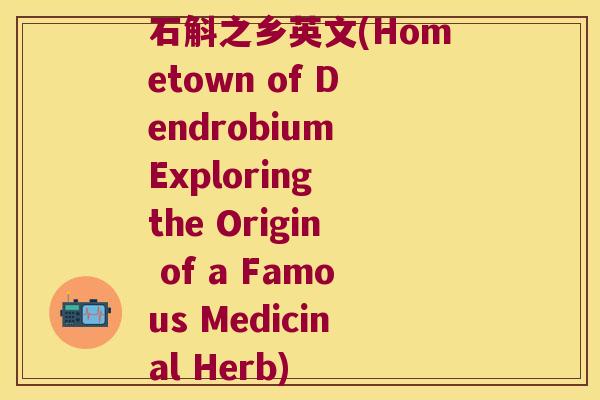石斛 贮存(如何储存石斛,让其更长久地保存?)
石斛的保存 石斛是一种常见的药用植物,它富含多种营养成分和活性物质,具有很多保健作用。但是石斛是一种易腐的食材,存放不当容易变质...
扫一扫用手机浏览
Dendrobium, also known as stone orchid, is a famous medicinal herb that originated in China. It has been used for thousands of years in traditional Chinese medicine for its various health benefits. Today, it is still widely used in the production of various herbal medicines, health supplements, and food products. The hometown of dendrobium is a small town in China where this delicate plant thrives in the wild. In this article, we will explore the origin of dendrobium and its importance in traditional Chinese medicine.
Dendrobium has a long and rich history in traditional Chinese medicine. In ancient times, it was believed to have magical powers and was used to treat various illnesses. According to historical records, dendrobium was first mentioned in the "Shen Nong's Classic of Materia Medica," which dates back to the Han dynasty (206 BCE - 220 CE). Since then, dendrobium has been included in numerous medical texts and has been used to treat a wide range of conditions. In traditional Chinese medicine, dendrobium is said to nourish yin, clear heat, and promote the production of body fluids.

Dendrobium is a tropical plant that thrives in warm, humid environments. It is native to China, Japan, Korea, and Southeast Asia. However, the wild dendrobium that is used for medicinal purposes mostly grows in China. The hometown of dendrobium is located in a mountainous area in the southwestern part of China, where the climate and soil conditions are ideal for its growth. The town is surrounded by lush forests and rivers, which provide a perfect habitat for this delicate plant.
The production of dendrobium is a tedious and time-consuming process. Wild dendrobium must be carefully harvested by hand, leaving the roots and stems intact to allow for regeneration. It is then dried in the sun or in a low-temperature environment to preserve its medicinal properties. In recent years, dendrobium has also been cultivated on a large scale to meet the growing demand for the herb. The cultivation process involves using special techniques to mimic the natural environment in which dendrobium thrives, such as controlling the temperature, humidity, and light.
Dendrobium has a wide range of uses in traditional Chinese medicine. It is believed to have numerous health benefits, including boosting the immune system, promoting digestion, improving vision, and relieving fatigue. Dendrobium has also been used in the production of various herbal medicines, health supplements, and food products, such as dendrobium tea, dendrobium capsules, and dendrobium candy. In recent years, dendrobium has gained popularity in the Western world as a natural remedy for various health issues.
Dendrobium has a long and rich history in traditional Chinese medicine and is widely regarded as a miracle herb. The hometown of dendrobium is a small town in southwestern China where this delicate plant thrives in the wild. Through careful harvesting and cultivation, dendrobium has become a widely used herb that is sought after for its numerous health benefits. It is important to appreciate the origin of dendrobium and its traditional uses in promoting health and well-being.